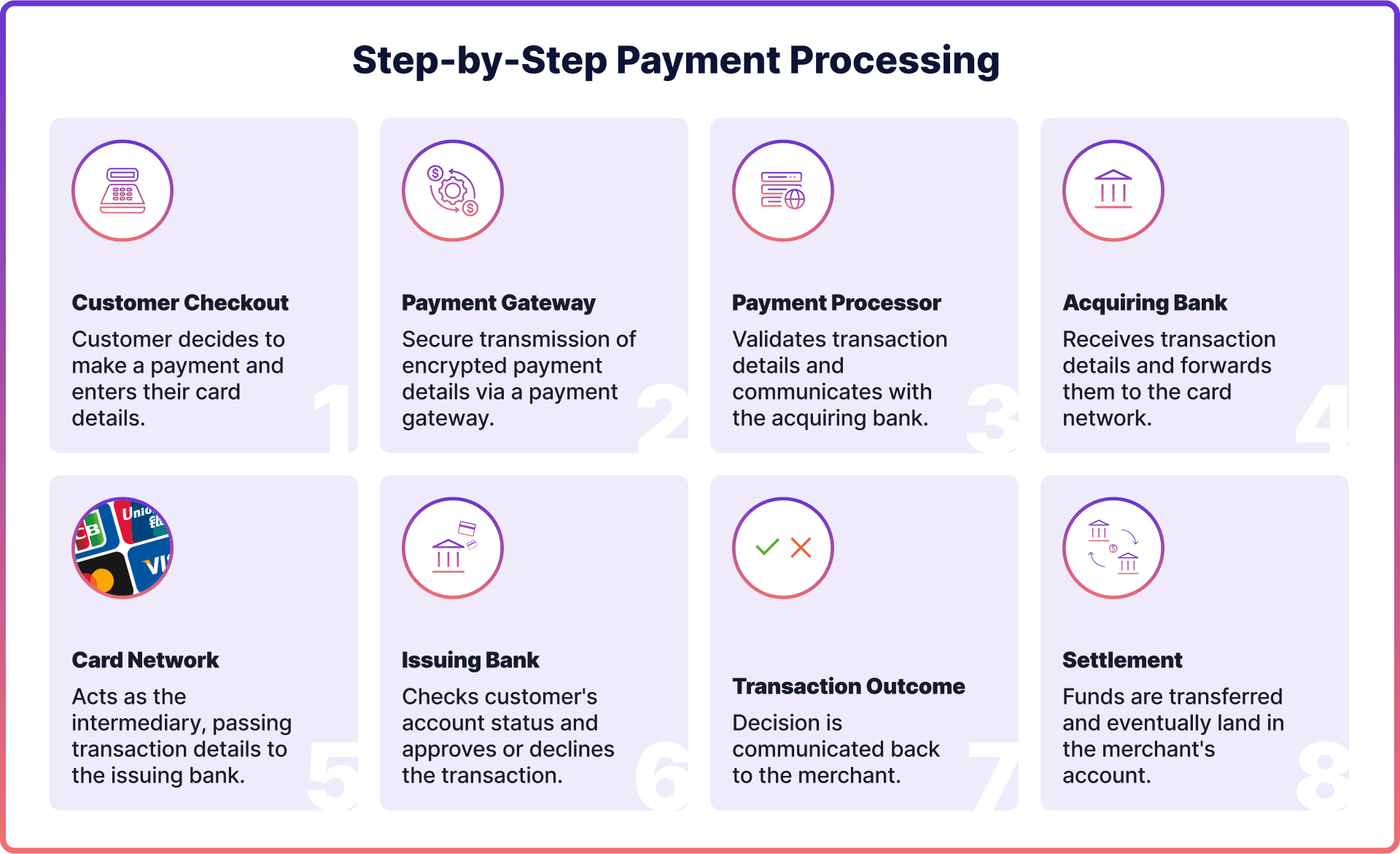Credit Card Processing for Online Clothing Store: Guide for Merchants


It’s finally happened – your online clothing store is open and ready for orders. But first, you need to set up a fashion retail payment system to ensure smooth transactions. Processing e-commerce payments can be nerve-wracking. It’s crucial for keeping your business running and involves sensitive financial information.
Most customers think paying for clothes online is as quick as clicking a button. However, it involves multiple steps and parties: the customer, merchant, payment processor, merchant account service, and both the customer's and merchant’s banks.
In this guide, we'll explain credit card processing for an online clothing store to help you choose the best fashion e-commerce solutions for your business.
The central figure in credit card payment processing is the processor itself. This fashion retail payment system enables your online boutique to accept payments from customers. The flow looks like this:
The customer starts the payment process by entering their credit or debit card details at checkout on your online clothing store. These encrypted details are then sent to the processor through a payment gateway, which connects your site to a merchant services provider.
The third-party processor then contacts the issuing bank to verify if the customer's account has sufficient funds for the transaction. The payment is either approved or declined. If approved, the customer receives an order confirmation.
Once the customer's payment is authorised and settled, the funds are deposited into the merchant's business account. This process may take a few days, depending on the banks and payment providers involved.

To start accepting card payments, you need to set up an apparel business payment gateway on your website. This gateway functions like a card machine in a physical store, collecting card information and passing it to the payment processor. There are various ways to integrate a payment gateway.
A hosted payment gateway, also called a redirect or third-party gateway, takes the customer to a secure checkout page of a third-party provider to enter their payment details. After the payment is processed, the customer is redirected back to your online clothing store's website.
This type of a payment solution for fashion retail may be suitable to businesses that value convenience and security, as it allows them to avoid processing sensitive payment data directly. It offers easy integration and built-in security measures. However, some customers might be hesitant to provide their payment information on a third-party interface.
Self-hosted payment gateway integrates the checkout page directly into your website. This approach requires more work and resources due to its technical complexity and your ultimate responsibility for the security of customer data.
The advantage of this type of payment gateway for an online boutique is that it builds a stronger relationship with the clients since they already trust your website and are less likely to abandon their shopping cart.
An API-hosted payment gateway enables your clothing store to send payment details directly to the processor through application programming interfaces (APIs). These are sets of instructions that enable secure communication between software systems. With this method, your online store doesn't need to store sensitive data on its own servers.
This method is arguably the best fashion retail payment system for merchants as it allows customer data to be collected on the merchant's site, maintaining a seamless user experience and preserving customer trust. The actual processing takes place offsite.
Credit and debit cards are still widely used globally, but newer payment methods are gaining prominence, which you may want to integrate as your fashion store payment options.
For example, digital wallets like Google Pay and Apple Pay have surpassed cards in global adoption. Not offering your customers’ preferred payment methods could lead to lost revenue from abandoned carts.
Digital wallets are now the most popular payment method worldwide, making up almost half – 49% – of all transactions in 2022, according to Statista. They allow consumers to store multiple cards and pay without manually entering card details.
They are particularly popular in Asian markets, with Alipay and Tenpay leading the way. Juniper Research predicts digital wallet transactions to grow from $9 trillion in 2023 to over $16 trillion by 2028, so their adoption is likely to continue growing, especially among younger consumers.
Not everyone prefers to pay for products upfront. Buy Now, Pay Later (BNPL) is a form of credit that allows customers to buy an item now yet pay at a later date. They generally offer the following payment plans:
BNPL gained popularity several years ago due to its flexibility during the financial recession. It's a favored payment option among Gen Z and millennials, with its adoption expected to keep growing. In 2023, Global Data valued the BNPL market at $309.2 billion, projecting it to reach $565.8 billion by 2026.
Open banking payments, also known as pay-by-bank, account-to-account (A2A), or direct bank payments, operate within the open banking ecosystem. Since the EU's PSD2 regulation enforced in 2018, banks must share customer data with licensed fintech firms via secure APIs. This regulation has driven the growth of open banking payments.
Pay-by-bank transactions bypass card networks, making them cheaper and more secure while offering a better UX. Customers don't need to manually enter card details as the process redirects them from the online clothing site to their trusted bank’s interface and back.
The FIS 2023 Global Payments Report showed that A2A payments reached $525 billion in global e-commerce transaction value in 2022. The report also predicted that A2A will make up 11% of e-commerce transactions by 2026.
Noda is a payments provider that offers merchant services for online clothing stores.
We can help you to set up card payment processing and gateway integration, offering intuitive UX, smart routing and a variety of popular payment methods.
Noda's advanced Open Banking API allows online businesses to easily integrate pay-by-bank transactions. With Noda you can also leverage AI-powered data analytics to forecast customer’s lifetime value (LTV) and personalise your marketing campaigns based on customers’ spending.
Noda’s payment solutions and features include:
We ensure the highest security of payments – from PCI DSS compliance to encryption and fraud prevention systems. Noda offers scalable plans and a variety of global currencies, connecting with 2,000 banks across 30 countries (UK, EU, Canada and now Brazil), spanning over 30,000 bank branches. Noda is your partner in growth.

